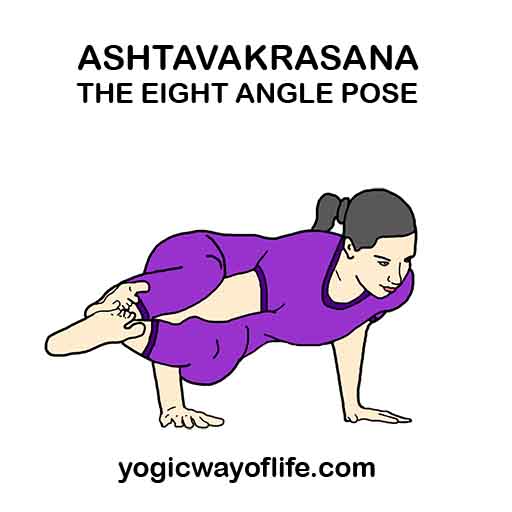Ashtavakrasana, the Eight Angle Pose is is hand balancing asana. In Sanskrit, Ashta means eight, Vakra means bent and asana is a pose. It is named after sage Ashtavakra who was born with eight deformities in the body due to a curse while he was in the womb. He is considered an enlightened master and was the Guru of king Janaka.
Ashtavakrasana does not find any mention in the ancient yogic texts, but has been incorporated in the modern times due to its benefits of strengthening the body and creating a sense of balance.

How to do Ashtavakrasana (The Eight Angle Pose)?
- Sit on the floor with legs extended. Relax and breathe normally. Place the hands on the thighs. This starting position is called Dandasana.
- Fold the right leg and place the right feet on the floor.
- Take the right hand and pass it under the right knee and place it on the floor. Place the right hand on the ground firmly and let the right leg rest on the right arm.
- Raise the right leg a little above the ground while it is resting on the arms near the elbow region.
- Firmly place the left hand on the floor next to the hips on the left side.
- Raise the left leg and place it on top of the right leg in a crossed manner.
- Now straighten out both the legs together in front of you. Both the legs are raised above the ground and try to keep it parallel to the ground. The right arm is squeezed between the two legs.
- Now comes the tough part. Try leaning forward a little and using both the arms, try to lift the body off the ground. This requires good strength of the arms and shoulders. Beginners should keep practicing to achieve this. The entire weight of the body rests on the two forearms. Your forearms and wrists should be strong enough to perform this pose.
- Once you are able to lift the body up, bend forward and lower the chest in the raised position, bending the elbows and making the chest parallel to the ground.
- This is the final position. Remain in this position for as long as you are comfortable. You can either hold your breath or breathe shallowly in this position.
- To release the pose, slowly straighten out the elbows and raise the body and let the buttocks touch the floor. Release the leg lock and place both legs on the floor. Hands can rest on the sides in Dandasana.
- The same process can be repeated on the other side too by bending the left leg and placing the right leg on top of it.
Benefits of this pose range from improved strength and concentration to better digestion.
Benefits of Ashtavakrasana (The Eight Angle Pose)
- Ashtavakrasana strengthens the wrists and arms as the entire weight of the body rest on the forearms.
- It gives a good sense of balance.
- Ashtavakrasana strengthens the core muscles of the chest and abdomen.
- It tones the abdomen and improves digestion.
- Ashtavakrasana improves concentration and steadiness.
- This is an advanced pose and gives confidence to those who are able to achieve the final pose with ease.
Contraindication for Ashtavakrasana
- Avoid Ashtavakrasana if you have any injury or sprain in the arms or shoulders. Be cautious especially if you have weak forearms.
- If you had any recent surgeries or injury of the legs, hips, shoulders or arms, then do not attempt this posture.

I definitely need a lot more practice in doing this pose. Your explanation of how to do this pose is brilliant and makes it look achievable, although I would need a lot more strength in arms, torso and legs before I attempt this.
I love your posts and explanations keep them coming as you have a great website.
Many Thanks.